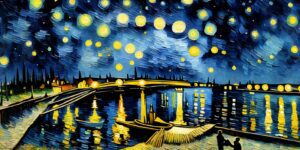Colors have long been utilized as powerful symbols in both art and literature, conveying deeper meanings, emotions, and concepts beyond their visual appearance. From the vibrant hues of a painting to the descriptive language of a novel, colors enrich the narrative and evoke profound responses from the audience. In this exploration, I will delve into the symbolic significance of different colors in art and literature, analyzing how authors and artists use color to convey specific concepts and emotions. Additionally, I will showcase examples of wallpapers inspired by literary and artistic works, explaining their symbolic significance.

Symbolic Meaning of Colors
- Red: Often associated with passion, love, and vitality, red symbolizes intense emotions and energy. In literature, red can represent desire, danger, or anger, depending on the context. In art, it can evoke feelings of warmth, power, and excitement.
- Blue: Symbolizing tranquility, depth, and spirituality, blue is often used to convey a sense of calmness and serenity. In literature, blue may represent melancholy, introspection, or infinity. In art, it can evoke the vastness of the sky or the depths of the ocean.
- Green: Representing growth, renewal, and harmony with nature, green is associated with vitality and abundance. In literature, green may symbolize youth, fertility, or envy. In art, it can evoke the lushness of landscapes or the freshness of spring.
- Yellow: Symbolizing joy, optimism, and enlightenment, yellow is a color of warmth and positivity. In literature, yellow may represent happiness, enlightenment, or cowardice. In art, it can evoke the brightness of sunlight or the richness of gold.
- Purple: Often associated with royalty, luxury, and spirituality, purple symbolizes power and mysticism. In literature, purple may represent royalty, extravagance, or magic. In art, it can evoke a sense of opulence and grandeur.
Use of Color in Art and Literature
In both art and literature, colors are used strategically to enhance storytelling and evoke emotional responses from the audience.
- Symbolic Associations: Authors and artists often use colors to imbue characters, settings, and objects with symbolic meaning. For example, the use of red in a painting may suggest passion or danger, while the use of blue in a novel may evoke a sense of calmness or sadness.
- Emotional Impact: Colors can evoke specific emotions and moods, setting the tone for a narrative or visual composition. Warm colors such as red and orange may create a sense of excitement or urgency, while cool colors such as blue and green may evoke feelings of tranquility or melancholy.
- Visual Composition: Colors are essential elements of visual composition in art and design. Artists use color palettes, contrast, and balance to create visually striking and harmonious compositions that draw the viewer’s eye and convey the intended message.

Examples of Symbolic Wallpaper Designs
- “The Great Gatsby” Wallpaper: Inspired by F. Scott Fitzgerald’s classic novel, this wallpaper features a luxurious Art Deco pattern in shades of gold and black. The gold symbolizes the opulence and extravagance of the Jazz Age, while the black represents the dark undercurrents of the characters’ lives.
- “Starry Night” Wallpaper: Inspired by Vincent van Gogh’s iconic painting, this wallpaper depicts swirling blues, yellows, and greens against a dark blue background. The blues represent the night sky, while the yellows and greens symbolize the stars and the landscape. The overall composition evokes a sense of awe and wonder, inviting the viewer to immerse themselves in the beauty of the night.
- “The Scarlet Letter” Wallpaper: Inspired by Nathaniel Hawthorne’s novel, this wallpaper features a bold red “A” against a black background. The red symbolizes the protagonist’s shame and sin, while the black represents the darkness and secrecy surrounding her life. The stark contrast between the red letter and the black background creates a powerful visual impact, mirroring the emotional intensity of the story.



In conclusion, color symbolism plays a significant role in both art and literature, enriching narratives and visual compositions with deeper layers of meaning and emotion. By understanding the symbolic significance of colors and how they are used by authors and artists, we can gain a deeper appreciation for the power of color to evoke emotions, convey concepts, and enrich our understanding of the world around us.
